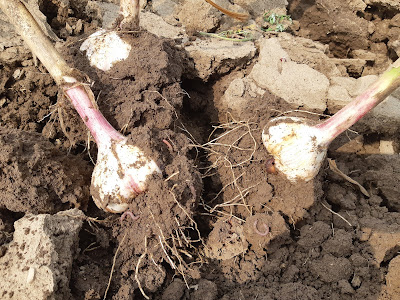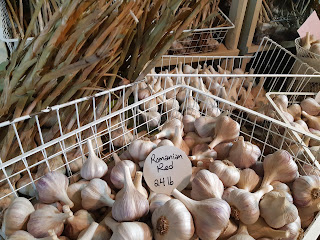I found the best way to preserve those early sprouting Turban garlics that you can never use up in time!
Black Garlic!
There is some controversy over black garlic, both over its origin and whether or not it is a fermented product, but there is no controversy in my soul when it comes to eating it!
Any garlic can be made into black garlic, though I've done some experimenting with different varieties, and the type of garlic you start out with definitely affects the flavour and texture of the final product. The machine used to make black garlic, and mainstream the process, was invented in Korea a couple decades ago, so many websites will claim that the process is relatively new, and that it originated in Korea. At the Guelph Organic Conference, this past January, I had the pleasure of speaking with an Asian woman who was selling black garlic, and she assured me that black garlic has been around a lot longer than the internet. It is a traditional ingredient in Asian culture, going so far back, she's not sure which country actually discovered it: China, Thailand or Korea.
All three countries have been making and eating black garlic for as long as anyone can remember, but they used a very different process than the hasty, convenient method of putting it in the machine pictured above. Traditional black garlic was made in clay crocks, buried in the ground along with coals from a fire that was stoked and fed for at least 30 - 40 days...gentleman, start your campfires...can you imagine tending to such a task, all the while being uncertain of the outcome of those precious garlic bulbs, hidden away and protected by the clay pot?
With great risk comes great reward! And, perhaps, there is no shortcut to effort. I wonder quite often if the commercial product really has the similar health benefits as the traditional black garlic. It's hard to say which one has been studied the most, and unless one can find the original paper publishing the results of the nutritional analysis, and said paper mentioned how the black garlic was made, or who it was purchased from, how can we really know what the information means? Quite often numbers just don't tell the whole story. They say black garlic has twice the antioxidants, and twice the vitamin C as fresh garlic. It also contains healthy tannins and has the added benefit of not giving you garlic breath. That sounds great, and I'll happily eat it up...especially with cream cheese on bread! But, also, another question to ask is what fresh garlic are we comparing it to, to say it has twice the benefit? Supermarket bulbs or locally grown organic garlic?
In the end, it's pure garlic that goes in, and nothing else, so I figure black garlic is at least as healthy as the garlic you start with. I'm not sure if a machine you plug in for nine days has the same result or intention as a fire you stoke for 40 days, but I bought one such machine, and I feel the benefits.
Like I said in my first sentence, it's a great way to make garlic keep forever! Store black garlic in an airtight container, and it'll even keep at room temperature for over two years (a fact which leans toward the idea that it really is fermented, to my mind).
I didn't start making it right away, so I can't say what fresh dug bulbs do in such a machine (there was a setting for venting/drying excessively wet garlic, but I didn't use it). I first got the black garlic maker in November, so I immediately did several batches of Turban garlic. It was so great, I discovered that Turbans make really lovely black garlic that is smooth and creamy. I can fit about 3.75 pounds fresh garlic in the wire basket that goes in the machine, so I tucked some different bulbs in with the Turbans to find out which varieties made the best black garlic (I made a map of the basket, lol, so I could still find them when they came out charred and transformed). 2.5 pounds of black garlic comes out of the machine, every nine days. Needless to say, I kept that machine going with new batches of bulbs for quite a few months.
I think October, November and December are probably the best months to make black garlic, with an extended period for varieties that keep really well and retain their moisture content, in the clove. As the cloves experience moisture loss, or prepare for sprouting, the texture gets more dry, they can get a charred taste if processed too long, and the flavour is compromised when they sprout.
My favourites for black garlic are Rocambole, Turban and Creole. All three are really flavourful, smooth and creamy. Porcelain holds up in any circumstance it seems, and makes for a solid product, with slightly more punch flavour-wise, and more structure, texturally. Artichoke Softnecks surprised me, because they were wholesomely flavourful once made into black garlic, with good texture to boot. Silver Skins are great and can be done after you are finished with most of the other garlic. Purple Stripes and Marbled Purple Stripes confirmed what we have been telling Garlic Festival goers for years: They retain their spunk, no matter what is done to them. Personally, I didn't like them as black garlic so much. It's not that they were hot (no black garlic is) they simply didn't have the richness and fullness you'd expect, and the texture was a little more grainy.
I just realized while writing this that I didn't do any Asiatic bulbs into black garlic, which surely is a sin, as it practically screams "Asian food" right in the name...Ah, well, project for next year!
We have a good stash of black garlic, and if any of you are wondering, you can certainly try some when you come out to the farm.
I'll end my post with a little game of eye spy in the picture below: can you spy our cloves of black garlic on the gorgeous, activated charcoal bread from Vann's Fine Bakery, of Stratford?
































